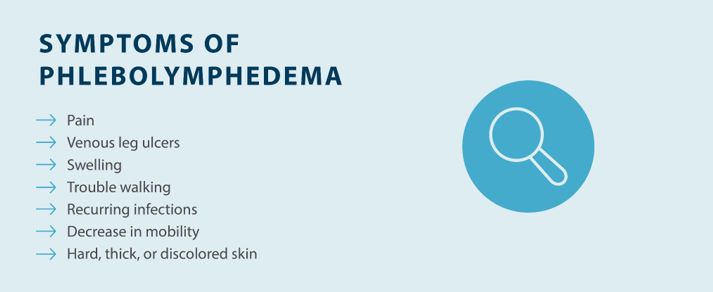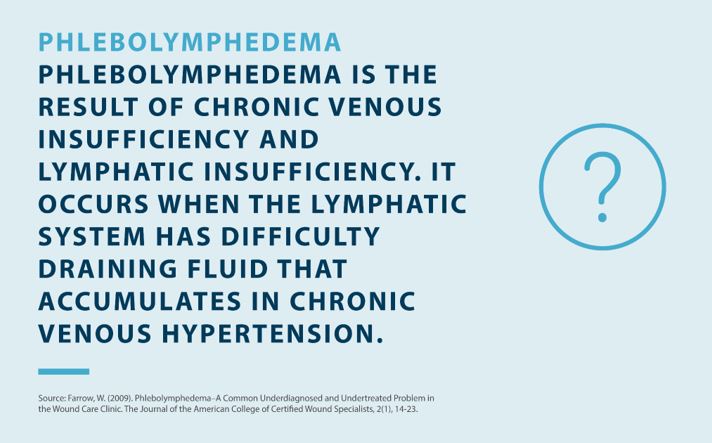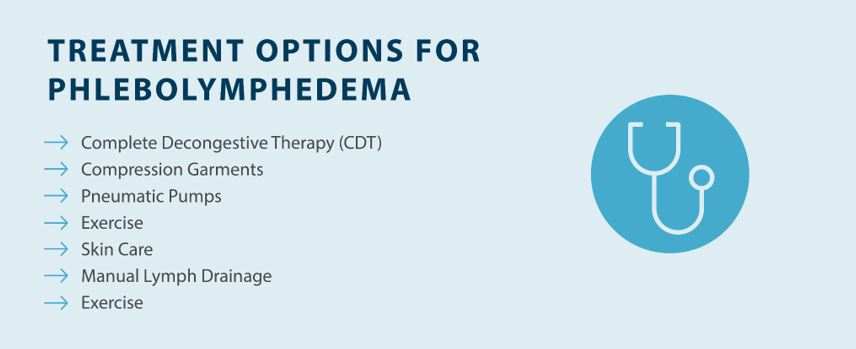Lymphedema and Weight Loss
Living with lymphedema while trying to manage your weight can feel overwhelming, but understanding the connection between lymphedema and weight loss can help you develop effective strategies for both conditions.
Read More

Phlebolymphedema is a type of lymphedema that involves a combination of chronic venous insufficiency and lymphatic drainage issues. This condition leads to swelling as a result of a buildup of fluid in the body tissue. As swelling increases and persists over time, it can lead to complications ranging from pain and discomfort to ulcers and infections. In this guide, we’ll explore phlebolymphedema in depth, including symptoms, causes, treatment, and more.
What Is Lymphedema?
What Is Phlebolymphedema?
What Is the Connection Between Lymphedema and Phlebolymphedema?
Why Does Early Detection Matter?
What Are the Symptoms of Phlebolymphedema?
How Is Phlebolymphedema Diagnosed?
What Causes Phlebolymphedema?
How Do You Treat Phlebolymphedema?
How Tactile Medical Can Help
Lymphedema is a type of edema caused by lymphatic dysfunction, or a problem with the lymphatic system. Your lymphatic system consists of a series of lymph vessels that carry lymph fluid. In a healthy body, lymph passes through many lymph nodes that filter out cellular debris, waste, and damaged cells. The lymph fluid continues to be processed and eventually returns to your bloodstream.
However, when there’s a blockage that causes lymph fluid to build up, it results in lymphedema. Lymphedema refers to the accumulation of fluid that results in swelling. Lymphedema can be primary or secondary, where primary lymphedema is present at birth and caused by genetics, while secondary lymphedema is caused by damage to the lymphatic system, such as an injury, cancer, or cancer treatment.
Whereas lymphedema is a result of lymphatic dysfunction, phlebolymphedema is a condition that’s caused by a combination of both chronic venous insufficiency (CVI) and lymphatic dysfunction.1

In a healthy person, blood is able to circulate throughout your body and return back to the heart. In patients with CVI, valves in the lower legs are unable to close completely, causing blood to flow backward. When this occurs, swelling may begin to occur in the lower legs, ankles, and feet. As CVI advances, it can result in lymphatic overload that leads to phlebolymphedema.2
Patients with lymphedema experience swelling as a result of a buildup of lymph fluid. This swelling occurs because lymph fluid is unable to pass through a lymph node or vessel, which causes it to accumulate in body tissue instead. Those living with lymphedema can experience swelling and other symptoms in various parts of the body, such as the head and neck, upper body, groin, arms, abdomen, and lower body.
Phlebolymphedema is similar to lymphedema but is the result of the combination of chronic venous insufficiency and lymphatic dysfunction. As a two-system failure, a phlebolymphedema patient will experience swelling that’s caused by vascular issues leading to lymphatic dysfunction, and if clinicians fail to address both the veins and the lymphatics, then the downward spiral of symptoms will continue. It’s important to note that multiple factors are at play when it comes to the development of phlebolymphedema, which prevents the lymphatic system from draining fluids properly.
Of all the different types of lymphedema, phlebolymphedema is the most common type of lymphedema in the Western world.1
Lymphedema and phlebolymphedema are chronic conditions that pose symptoms like swelling, pain, decreased mobility, and discomfort. While symptoms can be mild in early stages, complications can arise if preventative measures aren’t taken early on to reduce the progression of symptoms. Early detection helps you get started on your phlebolymphedema treatment plan as soon as possible. That way, you can minimize your symptoms and prevent some of the complications that can arise, such as an increase in infections or pain.
If you’re experiencing any symptoms that you think may be related to phlebolymphedema, lipedema, or any type of edema, you should schedule an appointment with your doctor at your earliest convenience. Your doctor can diagnose your condition using a basic clinical exam and, in some cases, imaging tests. Phlebolymphedema can be diagnosed during a clinical examination, so make sure you talk to your doctor about your medical history and all the symptoms you’re experiencing.
If your doctor is having trouble with a diagnosis or doesn’t think you have phlebolymphedema, consider getting a second opinion from another doctor or specialist. Lymphedema and phlebolymphedema are still understudied, and some physicians may not have the knowledge or experience to help. Early detection is key with all forms of lymphedema, as it can help you manage your symptoms and reduce chronic swelling.
Recognizing that you have — or may have — phlebolymphedema is one of the most important steps in treating and managing your condition. These symptoms are a sign that your swelling may be caused by a medical condition that requires treatment. If you’re experiencing any of the following phlebolymphedema symptoms, you should visit a doctor:1

Diagnosing phlebolymphedema is a crucial first step in getting the treatment you need to live a comfortable life and avoid complications. So, what can you expect when you go to the doctor to have your phlebolymphedema diagnosed?
Doctors typically begin diagnosing phlebolymphedema with a basic clinical exam. Your doctor will ask you about the symptoms you’re experiencing and examine your legs to check for swelling, skin problems, and other signs of phlebolymphedema.
Another simple diagnostic method your doctor may use is the Kaposi-Stemmer’s sign, where they will pinch a fold of skin. Typically, a doctor will pinch a fold of skin on the top of one of your toes, but this method can be used in other areas of the body, such as the legs or arms. If the skin easily tents, it is classified as a negative result, whereas a positive Kaposi-Stemmer’s sign occurs when the skin cannot be pinched. This is because it indicates that lymph fluid is preventing the redistribution of interstitial fluids.1 However, a negative Kaposi-Stemmer sign isn’t always accurate, so further assessments may have to be done.
Your doctor might also look at your medical history to see if you have risk factors. Oftentimes, this clinical examination is enough to diagnose phlebolymphedema, but that’s not always the case.
In the event that a clinical exam isn’t enough, your doctor may also use imaging tests. These tests are more involved than a basic exam but offer accurate results. If you’re having trouble getting a diagnosis from your doctor, you can inquire about a lymphoscintigraphy or echo-Doppler test.
There are several factors that can cause phlebolymphedema, and knowing the causes can help you better understand the condition. For some, phlebolymphedema occurs as a result of genetics, while others can be diagnosed with the condition due to certain types of acute trauma. Here are some of the most common causes of lymphedema and phlebolymphedema:

There is no cure for phlebolymphedema, which means the focus of phlebolymphedema treatment is on managing symptoms and preventing its progression. Below are some of the most common phlebolymphedema treatment and management methods:

Living with phlebolymphedema can make life challenging, especially if you’re having trouble staying active as a result. If you’re diagnosed with phlebolymphedema, the best thing you can do is start a treatment plan right away to relieve symptoms and prevent complications.
If you’re dealing with swelling and pain as a result of phlebolymphedema, Tactile Medical’s solutions can help. Our pneumatic compression devices help gently guide lymph away from swollen parts of the body so you can get relief. Check out the Flexitouch Plus system by Tactile Medical to learn more today.
________________________________________
Sources:
1. Farrow W. Phlebolymphedema-a common underdiagnosed and undertreated problem in the wound care clinic. J Am Col Certif Wound Spec. 2010 Apr 22;2(1):14-23. https://www.ncbi.nlm.nih.gov/pmc/articles/PMC3601853/
2. Ashforth, Karen. Understanding Lower Extremity Phlebolymphedema Fibrosis. Lymphatic Education & Research Network. https://lymphaticnetwork.org/news-events/understanding-lower-extremity-phlebolymphedema-fibrosis
3. Peters M, Syed RK, Katz M, Moscona J, Press C, Nijjar V, Bisharat M, Baldwin D. May-Thurner syndrome: a not so uncommon cause of a common condition. Proc (Bayl Univ Med Cent). 2012 Jul;25(3):231-3. https://www.ncbi.nlm.nih.gov/pmc/articles/PMC3377287/
4. National Center on Birth Defects and Developmental Disabilities , Centers for Disease Control and Prevention. What is Venous Thromboembolism? 2022 Jun. https://www.cdc.gov/ncbddd/dvt/facts.html
5. Reid, Tony. Congestive Heart Failure. http://www.lymphedema.com/heart.htm
Living with lymphedema while trying to manage your weight can feel overwhelming, but understanding the connection between lymphedema and weight loss can help you develop effective strategies for both conditions.
Read More
Stage three lymphedema is the most advanced stage of this chronic condition. In this stage, the affected body part might display one or more symptoms, such as significant swelling, alterations in the skin, or recurring episodes of infection. While this stage can be challenging to manage, understanding your condition and...
Read More
When the lymphatic system becomes compromised, fluid buildup can lead to stage 1 lymphedema, a condition marked by mild but noticeable swelling in affected areas. This initial stage is a crucial window for intervention, as proper treatment can prevent progression to more severe stages. Knowing the signs, causes, and treatment...
Read More
Living with stage 2 lymphedema brings unique challenges, but understanding your condition is the first step toward effectively managing it. While this stage marks a point where the condition becomes irreversible, there are many ways to maintain your quality of life and prevent symptoms from progressing. Keep reading to explore...
Read More
Call us at 1.800.575.1900